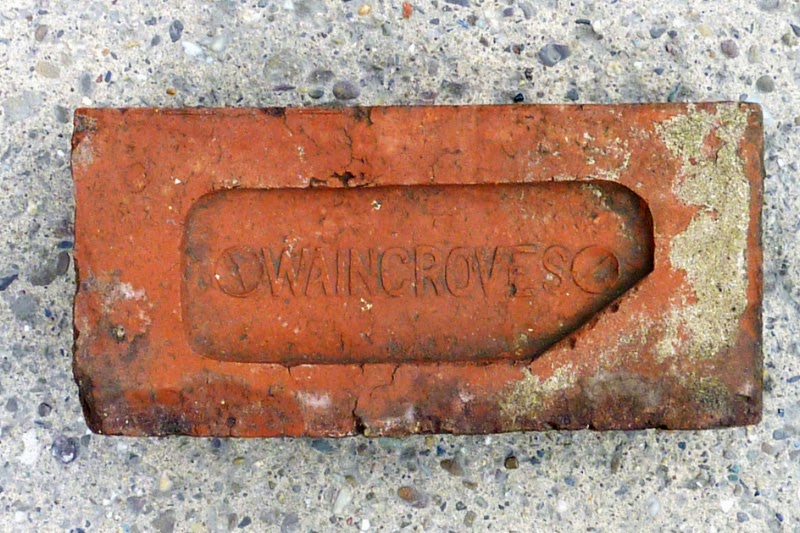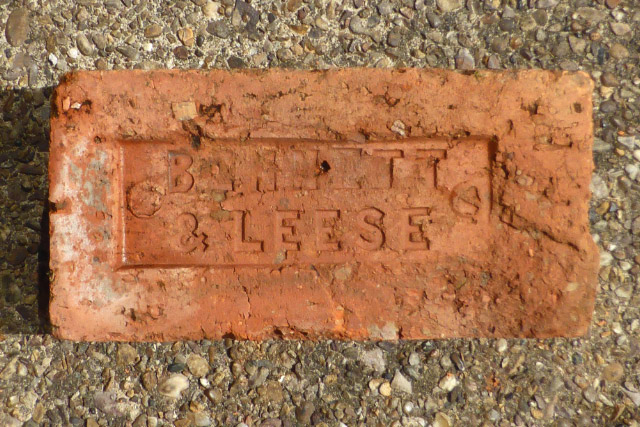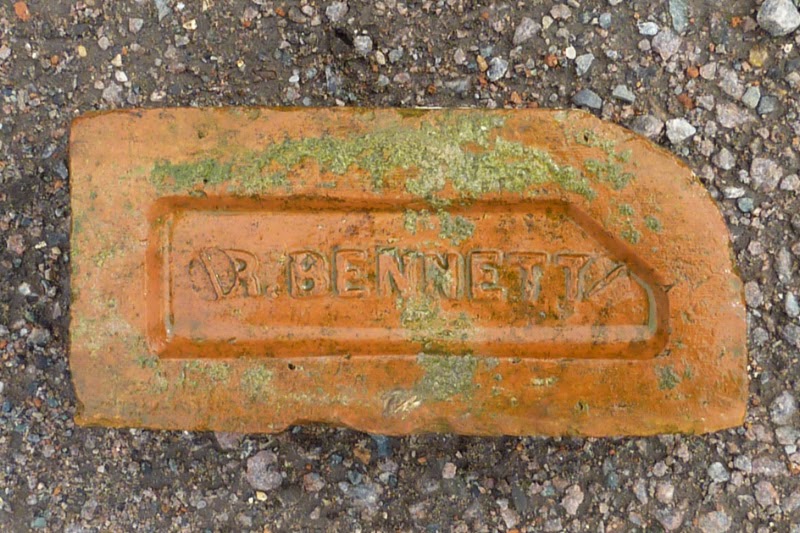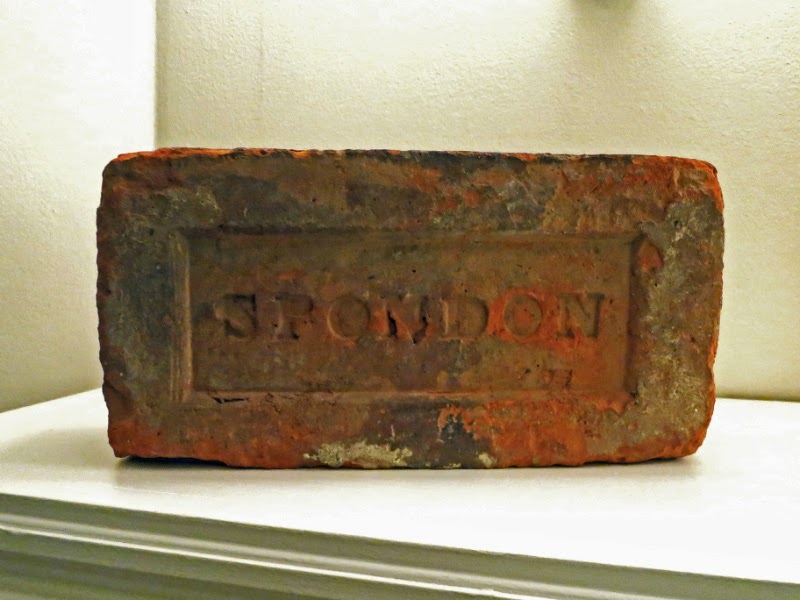Researching brick & tile makers Tucker’s has revealed that the family operated four works in Loughborough in their 116 years of production. During all of this time the company traded as G. Tucker & Sons, named after it’s founder Gilbert Tucker who was later joined by his son Gilbert junior at the brickworks. So I start with the family timeline for the company after which I cover the different works & the years they were in production.
Gilbert Tucker senior (1806-1876) had started his Park Lane brickworks, Loughborough by the 1851 Census in which he is listed as a brickmaker, before this date he had been a publican/maltster. I have a date of 1848 when Gilbert established his brickworks, but this cannot be verified. He was joined at the works by his son Gilbert Tucker junior (1838-1920) & this event is recorded in the 1851 Census with Gilbert junior being listed as a brickmakers assistant. The 1861 Census now records Gilbert junior as a master brickmaker & another of Gilbert senior son’s, Nathan (born 1841) is also recorded as a brickmaker in this census. By the 1861 Census Gilbert junior had married & left the family home & was living on Bedford Street. We then find in the 1871 Census Nathan (now an invalid) & his wife were living with Gilbert senior & his wife on Park Lane. One can only surmise if Nathan had an accident at the brickworks ? Gilbert senior died in 1876.
Gilbert junior was joined by his two sons, William & Arthur at the brickworks. Eldest son, William Trueman Tucker (1861-1925) was first a book keeper, then in the 1891 Census he is listed as a brick manufacturer. The 1911 Census lists him as Managing Director of Tuckers. William Trueman Tucker was joined by his son William Jones Tucker (1885-46) at the works & in the 1911 Census William Jones Tucker is listed as a brickmaker. William Jones Tucker’s son David William Tucker born in 1925 became an architect & it appears that he took no part in the running of Tuckers.
Gilbert junior’s second son, Arthur (1869-1936) was a manager at the brickworks in the 1901 Census & in the 1911 Census he listed as Brick & Tile Manufacturer. Arthur’s son, Arthur Leslie Tucker, born 1907 is recorded as a brickmaker in his father’s 1936 Will.
The article where I obtained this family info from does not record who ran Tucker’s after 1925, so I am taking it that it was first William Jones Tucker, then after his death in 1946 that it was his cousin Arthur Leslie Tucker, but this can not be verified. The Butterley & Blaby Brick Co. took over Tuckers in 1964 & ran Tucker's remaining two Loughborough works until their closure in 1966 & 1967.
As said Tuckers operated four brickworks over the years & these where situated on Park Lane (this road was later renamed Beacon Road), Park Road (this road had previously known as Far Park Lane in the 1860’s/70’s), William Street & the Great Central Works situated on Windmill Road (the part of the road where the works was accessed was later renamed Beeches Road).
Gilbert senior in 1848 established his first works on Park Lane & is coloured yellow on the 1883 OS map & corresponding maps below. The 1851 Census records him as living on Far Park Lane (later re-named Park Road). The first trade directory entry that I have for Gilbert Tucker & Son is in White’s 1863 edition when his works is listed as being on Park Lane (yellow). We then find in Harrod’s 1870 edition that a 2nd works is listed on Far Park Lane (Park Road) & is coloured green on the 1883 map below. It’s unknown what year this yard was started.
© Crown Copyright. Reproduced with permission of NLS/Ordnance Survey 1883.
© Crown Copyright. Reproduced with permission of NLS/Ordnance Survey 1900.
© Crown Copyright. Reproduced with permission of NLS/Ordnance Survey 1919.
© Crown Copyright. Reproduced with permission of NLS/Ordnance Survey 1938.
I have to say at this point Gilbert senior died in 1876 & Gilbert junior took full control of the business. Kelly’s 1876 edition records two Tucker entries, the first is G. Tucker & Sons, Forest Road, Loughborough & the address of Forest Road could be Gilbert junior’s home address as he is recorded as living at 12, Forest Road in the 1871 Census. There is an alternative option for the Forest Road entry as the William Street brickworks (Tucker’s 3rd yard) is shown on maps as being also being accessible from Forest Road.
The second Tucker’s entry in Kelly’s 1876 edition is for Tucker & Moss, Radmoor, Loughborough & this is the William Street works coloured blue on 1882 OS map below. William Street is coloured orange & Forest Road is red. I have found that James Moss had been in partnership with Gilbert senior from at least 1860. There are two more trade directory entries for Tucker & Moss in White’s 1877 & Wills Almanac 1878 editions & it will have been Gilbert junior who was in partnership with Moss at these dates. I am taking it that this partnership ended soon after 1877 possibly with the death of James Moss ? It is not known if Gilbert junior continued to run this works after 1877, but the yard is still shown on the 1901 map then gone on the 1919 map. Trade directories reveal that after 1891 only G. Tucker & Sons are listed as brickmaking in Loughborough, so I can only surmise that Tuckers were still running this William Street works up to the beginning of the 1st World War. If I get the answer to this question, I will update the post.

© Crown Copyright. Reproduced with permission of NLS/Ordnance Survey 1882.
Next I found an entry in the London Gazette dated 23rd of May 1878 which records that Gilbert Tucker (junior) of Loughborough, Brickmaker & George Hodson of Loughborough, a civil engineer had given notice in respect of the invention of "improvements in kilns for drying bricks, tiles, terra-cotta, sanitary pipes & other pottery ware, lime, cement & for salt glazing”. Whether this amounted to an actual Patent, I do not know. https://www.thegazette.co.uk/London/issue/24329/page/3127/data.pdf
Kelly’s 1881 edition again records Gilbert at Forest Road, then in Kelly's 1891 edition the listing is for the Park Road works (green). Kellys 1895 lists just Loughborough. We next find along with the Park Road works there is a new works listed in Kelly’s 1899 edition & this is the Great Central works (4th works) & I have coloured this works purple on the 1901 & 1938 maps below. This newly established works was situated off Windmill Road, just south of the Great Central Railway Station. The works was served by it’s own railway line which ran into the centre of the works & the company used a Hoffman type kiln to produce their bricks. Part of Windmill Road was later renamed Beeches Road (sometime between the 1901 map & the recording of this renamed road on the 1919 map). The 1938 map below shows this change & I have coloured Beeches Road red.
© Crown Copyright. Reproduced with permission of NLS/Ordnance Survey 1901.
© Crown Copyright. Reproduced with permission of NLS/Ordnance Survey 1938.
Kelly’s 1900 entry is same as 1899, then from Kelly’s 1908 edition to the last trade directory available in 1941 the entry is G. Tucker & Sons, Great Central Brickworks. Loughborough. A 1951 advert for the company lists 3 yards & these are Great Central, Beacon Road (formally Park Lane) & Park Road. I have found however that the Park Road works is shown as disused on the 1919 & 1938 OS maps & these two dates coincide with both World Wars, so this works may have been temporally closed at these two times due to shortage of men to operate them. It is unknown when the Park Road works closed for good, but it may have been in the 1950’s. As said the Butterley & Blaby Brick Co. took over Tucker’s two remaining works in 1964 & a newspaper article records that the Beacon Road (Park Lane) works closed in April 1966 due to the lack of demand for bricks & the un-economical cost to Butterley & Blaby to update the works to using modern oil-fired kilns. The Great Central works did not last much longer either with Butterley & Blaby closing it in 1967, thus ending 119 years of brick production at all of the Tucker’s works.
So on to the dates (known & estimated) that Tuckers works are thought to have been operational.
William Street - 1876, but may have been as early as 1860 to the early 1910’s.
Park Lane later re-named Beacon Road - 1858 to April 1966.
Park Road - previously called Far Park Lane - 1870 to mid 1950’s.
Great Central works - 1898 to 1967.
Going back to the William Street works & with it being accessible from Forest Road via a footpath, both Lynne & fellow Loughborough brick researcher Richard Thorpe have informed me that this old footpath goes to the Ingle Pingle allotments & it then carries on to the old brickwork's clay pit which is now full of water. There is however a new footpath called Emanuel Way which takes you round to the pond. I have just been informed (9.6.20.) that a large steel fence has been erected to protect you from going to near to this very deep water & the pond is no longer visible because the area is all overgrown, so I have added a link to Google maps for you to see this former brickworks site & another Google maps link to the street view of the pond from Adam Dale road.
The Great Central works is now covered by the housing on Tucker’s Road & the claypit now filled with water was once called Tucker’s Pond is now called Charnwood Water & there is a footpath around this water to have a pleasant walk around.
Tesco now occupies the site of the Park Road works & the nearby Park Lane (Beacon Road) works is now an industrial site & there is a park between this site & Tesco’s.
The 1883 map above of Park Lane & Park Road also shows a brickworks situated on Ling Lane which I have coloured red & with finding one trade directory listing for Joseph Griggs & Co. Loughborough in the Brick Makers section of Kelly's 1881 edition there is the option Joseph Griggs owned this Ling Lane yard. The 1881 census reveals Joseph Griggs is listed as a Timber Merchant living on Forest Road, Loughborough. So it appears Griggs delved into brick making for a short period of time because we find he is still listed as a Timber Merchant in the 1891 census. This Ling Lane works is no longer shown on the 1900 OS map.
Another Loughborough brickmaker James Bombroffe is listed in trade directories from 1863 to 1877 as brickmaking with the address's of Middle Park Lane & Park Lane & from the 1861 & 1871 census I have established his yard was next to Gilbert Tuckers on Park Lane, with both men recorded as living at Brickyard Cottages in the 1861 census, then living next door to one another in the 1871 census on Park Lane. With these two brick yards being situated halfway down Park Lane, I have come to the conclusion that this is how the word Middle was added to describe the location of these two brick yards. The larger scale 1883 OS map below shows Tuckers yard & what was left of Bombroffe's yard (coloured orange) which were the clay pits which had filled with water. I then found in the 1881 census that Bombroffe was still brickmaking & had moved to Syston, living on Oxford Street & possibly working at a brickyard which is shown on the 1883 map as being a short distance from Oxford Street along a Public Footpath. No bricks stamped Bombroffe have so far turned up. Please note Gilbert Tucker also owned the other works shown on this map, situated on Park Road.
© Crown Copyright. Reproduced with permission of NLS/Ordnance Survey 1883.

Now back to Gilbert Tucker. Although I have found quiet a few of these Genuine Hand Made bricks, not one of them has been pressed crisp enough, so that you can read all of the letters perfectly.
This is the reverse of Genuine Hand Made & is the best example that I have ever found, the other side of this brick, you can hardly read. That's hand mades for you.
Tudorstyl was one of Gilbert's brand names. The others being TSL, Newstyl & Multiruf, examples of each are shown below, but I think the Newstyl & Multiruf examples below were made in the 1960's with these examples having the name stamped on the end of the brick & we know the Newstyl came from a house built in 1963. The Multiruf brand of bricks was first introduced by Tuckers in1916 & are still made today by Hanson, at their works in Desford, Leicestershire.
Hanson's came by the Multiruf name when the Butterley Brick Company purchased Tucker's in 1964, Butterley in turn were then taken over by the Wiles Group/Hanson Trust in 1968. In 2007 Hanson Brick became part of the Heidelberg Cement Group. I can now update that in 2015 Hanson's was sold to Forterra & rebranding to that name took place with immediate effect. In 2018 an application was put forward by Forterra to build a new Desford plant adjacent to the old works & will be operational in 2021 with the capacity to produce 180 million bricks per year.
Photographed by David Haslam in-situ at his 1963 built bungalow in Leicestershire.
Photographed by Angela Lyons in-situ at her 1963 built bungalow in Mapperley Park, Nottingham. The 1939 advert shown later in the post advertises Tuckers were making Newstyl bricks back then.
This Multiruf example with having the registration number stamped in it may have been made anytime after 1919 when the Multiruf name was first registered as a trade mark.
Leicester Daily Mercury - Tuesday 16 March 1937.
Image © Reach PLC. Image created courtesy of THE BRITISH LIBRARY BOARD.
Leicester Evening Mail - Monday 28 April 1952.
Image © Reach PLC. Image created courtesy of THE BRITISH LIBRARY BOARD.
This Multifuf brick may have been made before the name was registered as a Trade Mark in 1919.
This machine made brick by Gilbert is dated 1888, the same year as the entry in Wright's Trade Directory.
In the 1860's Gilbert was asked by Edward Gripper to supply some of the facing bricks (possibly like the brick above) for St. Pancras Station & Hotel in London, as the Nottingham Patent Brick Company, who were the main brick contractor, could not keep up with the demand for the 60 million bricks that it eventually took to build the Station & Hotel.
Another dated brick, this one is 1887.
Another variation of Gilbert's work. You have to study this one to decipher the letters of G. T. & Sons. To see the lettering more clearly I have now added this tile which has the addition of Limited.
These next two bricks, TSL - Tucker & Son, Loughborough, I believe were made either by William Trueman Tucker or by his son, William Jones Tucker. I have found many examples of these bricks with the large letters on, the last ones seen where at the old Mansfield General Hospital which was demolished in 2014.
With receiving an old advert (shown at the end of the post) in March 2022, I can now reveal that Old Style TSL & Rustic TSL bricks were made from at least 1914 onwards.
Added - 9.2.15.
John Spencer has sent me his childhood memories of growing up near Tucker's brickworks. He has also sent me maps showing the locations of both yards. The Park Road works is partly built on with houses & Tesco. The second on Great Central Road has houses built upon it with one of the roads being named Tuckers Road & the old clay pit has been formed into Charnwood Water.
John writes :- Growing up I lived on Park Road near the cricket ground and from our back bedroom window, could clearly see the main chimney of the Tuckers Road site, belching black smoke as the coal boiler was fired up. (1960-1967) The kilns (of which there were many) also periodically spewed smoke which again was visible in the distance. This used to fascinate me and as a teenager prior to site being cleared spent many happy hours exploring it with a few mates.
Up the road next to where Tesco now stands is a Catholic church. To the left of the church was a short overgrown lane with a huge derelict brick building at the end. Again there was a tall brick chimney to it's rear which I now take to be the pump house for the brick pit behind. On the opposite side of the flooded pit and then totally overgrown site (Beacon Rd side) is where the kilns had stood into the late 70s, the flooded part-filled pit lay in between.
A local builder (Wm Davis) bought the site around 1967? and used the pit to dump building waste in. Unfortunately they lobbed in a good few tonnes of plaster board which then began to liberate rather large quantities of hydrogen sulphide gas giving rise to what became known as the Shelthorpe smell! (gut wrenchinly strong rotten egg) The problem took considerable time and effort to cure despite capping the pit with clay, again it stood derelict until the late 80s when the supermarket was built.
The border of the site as I knew it extended, at it's eastern end, between Park Road & Beacon Road along the line of Landsdown Drive and at it's Western end between Parklands Drive and Beacon Road along the line of Crosshill lane. The Crosshill lane section was and still is used for agriculture. Whether or not it was quarried I don't know but if it were it would have been back-filled long before I was born.
I guess this was the original hole used for St Pancras.
Interestingly I have seen and nearly acquired the last ever brick made by Tuckers. As a 4-5 year old my Mum used to take old textiles from home to a Rag man on Craddock St in Loughborough. The company, long defunct, was called Johnsons Metals and operated from a little yard next to the old dole office on Buckhorn Square. Just inside the office door on the window ledge was a proudly displayed a brick stamped "The last Brick Made By G Tucker and Sons". As a teenager some years later and prior to the area being redeveloped I "weighed in" some bicycle parts and tried to persuade the guy to sell me the brick as I (for some reason) found myself drawn to it. Needless to say he wouldn't !
Thanks John for sharing your memories.
I wonder what's happened to that Last Brick now ?
I would certainly like to have a photo of it, so If anyone knows of it's location, please get in touch.
Added 8.5.22.
Barry Peabody has emailed me with his childhood memories of Tucker's Beacon Road works. Many Thanks, Barry.
I just seached on the Phorpres name (Peterborough) having seen one of their sample bricks at a collector's fair in Shrewsbury. I knew the name and nearly bought it, but it set me thinking of the name of the Loughborough brick works opposite where I lived from the late 1940s to 1963 - and that is how I found your great site.
I lived at 1 Holt Drive, which is directly opposite the Beacon Road entrance of Tucker's brickworks. Holt Drive (and others) only show on the 1938 OS Map because the houses weren't built until 1936 (or thereabouts). I moved to London in 1963 and my parents moved to Shepshed in the late 1960's and by then on the frontage of the old brickworks, the Beacon Pub had been built. I remember the issue of the "Shelthorpe Stink" because it was some years before the filled-in quarry could be built on. They had to install breather pipes to disperse the methane and it was often discussed whether it was (or ever would be) safe to build on it because of the fill that had been used.
Even as a kid, I don't think the quarry could have been used because (always against our mother's warning) we used to slide down the steep slope on our backsides and try to stop before hitting the water that lay in the bottom of the pit. Walking back up to do it again was always a struggle. I suppose the clay marks on our rear ends was always a giveaway as to where we'd been. It was easy to get onto the site through a gap in the railings alongside Beacon Road. The water was a good place for frog and toad spawn and when the froglets were big enough the disperse they left en masse and crossed Beacon Road. At times it was like a blanket of small frogs and, even with the lower number of cars then, many of them were squashed.
A 2018 find at Cawarden Reclamation, these bricks were mixed in with TSL bricks on the pallet & may have been made by the Butterley Brick Co. during their three years ownership of Tuckers. Up to yet no bricks stamped Butterley Brick Co. Loughborough have been found. Below is a TSL variation found at Cawarden in May 2022. The cross may signify when it was made ?
Gilbert Tucker intertwined Trade Mark tile found at Cawarden Reclamation Yard in June 2020 & below is a 1927 advert bringing your attention to " Without this Mark none are Genuine."
Reproduced from the Richard Thorpe Collection.
I found this Loughborough Bricks - G. Tucker & Son Makers in April 2021 & it was the only one mixed in with many other bricks at a reclamation yard. I am wondering if it was made around 1927 with the company also advertising their Loughborough Roofing Tiles as shown in the advert above.
Many thanks to Paul & Cynthia for sending me these three adverts, added 3.3.22.
The Architects Compendium 1911
The Architects Standard Catalogue 1914-17
The Architects Standard Catalogue 1939-41
An in-depth account of the family history of Gilbert Tucker & his descendants can be read at this link.
http://lynneaboutloughborough.blogspot.co.uk/2016/04/tuckers.html
Many thanks to -
Lynne from Loughborough who's article has been invaluable in establishing the Tucker's family tree.
Richard Thorpe, also from Loughborough for supplying me with photos, info & trade directory entries for this post.
David Haslam & Frank Lawson- brick images.
John Spencer - his account of Tucker's.
Barry Peabody - childhood memories of Tucker's.
Added - 2.12.18.
I have added this South Leicester Colliery Co. brick with it having G. Tucker stamped in it. This company is first listed in trade directories in 1891 & the date matches when Gilbert junior was brickmaking. So if it is the same Gilbert why is he recorded as an agent for the colliery company. If I find the answer I will update the post.









































































































